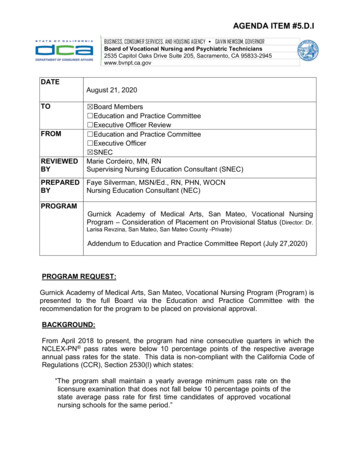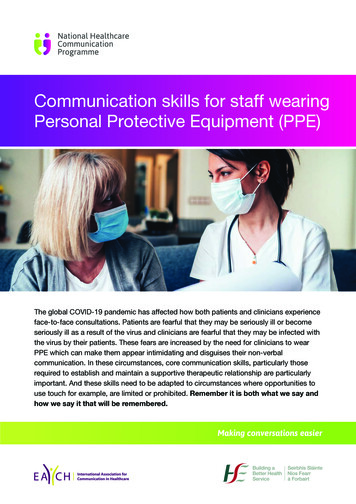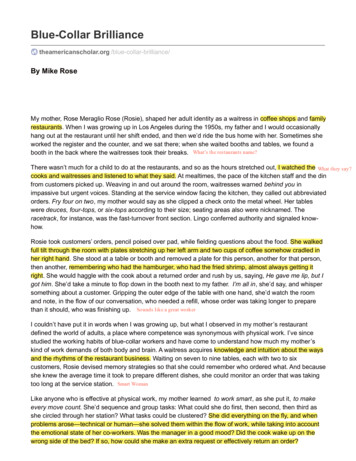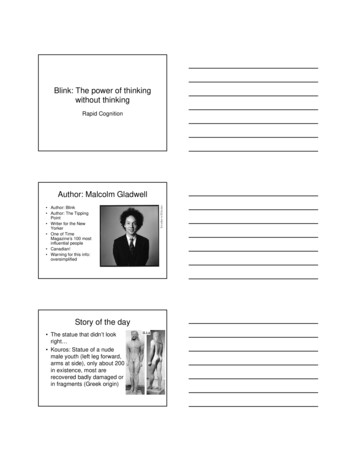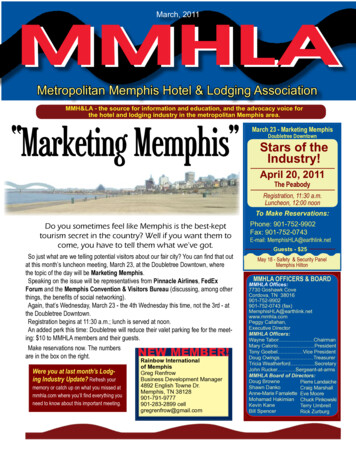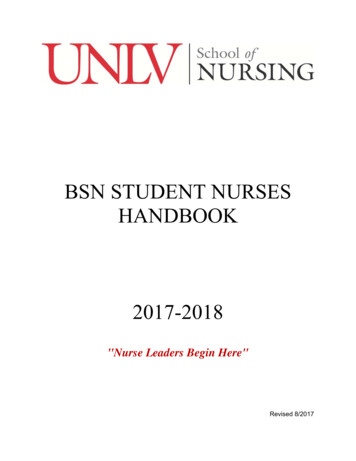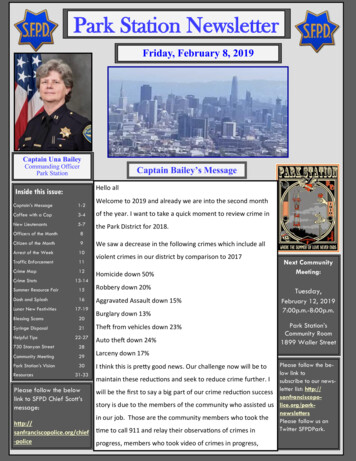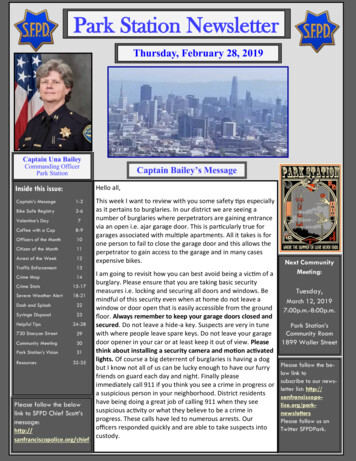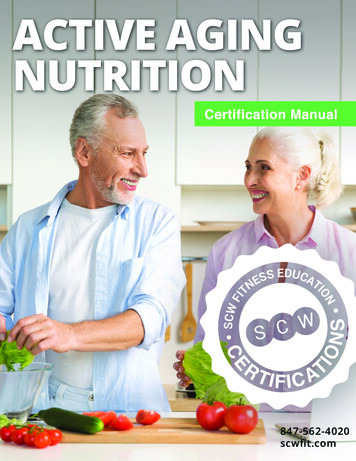
Transcription
About the Author:TRICIA SILVERMAN, RD, MBATricia is a registered dietitian and the 2016 SCW Fitness MANIA Boston Idol Winner.She specializes in employee/group wellness seminars and programs. She is aWellcoaches-certified wellness coach, an AFAA-certified group fitness instructor, anACE-certified personal trainer, and she is certified in Barre through SCW and BarreAbove . Her program, Collide, is a unique combined nutrition and exercise series. Shehas an MBA and teaches Nutrition Entrepreneurship and Healthy Aging at NortheasternUniversity.2
SCW Nationally Recognized CertificationsSCW Fitness Education is a nationally recognized certification organization that hastrained over 100,000 Fitness Professionals. Our certifications are recognized by fitnessfacilities across the USA and Internationally. The SCW Fitness Education Certificationsare both general and specialty in orientation and span from Group Ex, PersonalTraining, Aqua, Yoga, Barre, Pilates, Sports Nutrition, Weight Management, KettleWeights and more. Each certification is developed and lead by qualified, veterantrainers that have 20 years of fitness experience. Theory, practice, and applicationcombine to credential our SCW professionals and prepare them for quality instruction atlarge, small and specialty facilities.Most SCW Online Certifications are presented live at each of our SCW MANIA conventions. When offered, our live certifications are free (within one year) for thosewho have completed the courses.SCW Fitness EducationSCW is an internationally recognized education body that provides hands-oncertifications and continuing education courses and conventions to fitness professionalsin multiple disciplines nationwide. For the past 29 years, since 1987, Personal Trainers,Group Exercise Instructors, Small Group Training Leaders, Aquatic ExerciseProfessionals, Cycling Teachers, Mind-Body Experts, Sport Specific Training Educatorsand many more get certified through SCW. This outstanding Family of Leaders alsosupports Managers, Directors and Owners of clubs and facilities nationwide. As thelargest Conference Leader and Continuing Education Provider in the world, MANIA offers eight Professional Training Conventions in New York, California, Florida, Atlanta,Dallas, DC, Midwest (Chicago), and Boston serving over 10,000 health and wellnessprofessionals and reaching over 90,000 virtually.SCW Certifications Published bySCW Fitness Education3675 Commercial Ave.Northbrook, IL 60062847-562-4020www.scwfit.comCopyright 2017 by SCW Fitness Education.All rights reserved. No part of this publication may be reproduced or distributed in anyform or by any means, or stored in a database or retrieval system, without the writtenpermission of the publisher. SCW Fitness Education logo and all images on covers andherein are the property of the publisher and cannot be reproduced without prior writtenapproval from the publisherDisclaimer:The authors and publisher of this material are NOT RESPONSIBLE in any mannerwhatsoever for any injury which may occur through reading or following the instructionsin this manual.3
Course Goal:Welcome to the SCW Nutrition for Active Aging course to study nutritionalfactors that enhance wellness in those 50 and older. Our certification program is aneffective way to gain perspective on the unique nutritional needs of Active Agers.Acquiring this knowledge makes you more marketable to the Active Agingpopulation and gives you a better understanding of the intake needs of your clientsin the Active Aging age group.Learning Outcomes:Upon completion of this course, participants will be able to: 4Describe the leading causes of mortality.Describe calorie needs of Active Agers.List macronutrient ranges for Active Agers.List and explain the protein intake necessary for optimal aging.List and explain micronutrient needs, and sources in Active Agers.Describe fiber needs, and fiber sources for Active Agers.Describe hydration needs of Active Agers.Explain how MyPlate can be used to promote a healthy pattern of eating.Explain nutrition strategies to help prevent the leading causes of death.Explain the fundamentals of the Mediterranean and Dash Diet.Identify and describe the longevity factors in cultures known for living longlives.Explain how meal plans based on MyPlate can help people meet theirnutritional needs.
Table of ContentsChapter 1: IntroductionChapter 2: Eat for energy and to build and maintain lean body mass.Part 1: Maintain a healthy weight.Part 2; Lose weight through gently reducing calories and addingmovement, the power duo for Active AgersChapter 3: Balance macronutrients and don’t forget micronutrients!Part 1; Follow these protein recommendations for Active AgersPart 2; Eat carbohydrates for energy and for optimal brain functionPart 3; Eat healthier sources of fat to protect your heart and brainPart 4; Be sure to eat foods that contain the micronutrients for optimalActive Aging healthPart 5; Drink at least 6 cups of water a day, and as you increase fiberintake, increase water intake.Part 6; Drink alcohol in moderation, and don’t start if you don’t drinkChapter 4: Use healthy eating patterns and meal plans as helpful tools toguide optimal Active Aging food intakePart 1; Use Dietary Guidelines Eating Patterns and MyPlate tools tohelp guide healthy food choices and portionsPart 2; Use SCW’s Meal Plans to optimize nutrition intakeChapter 5: Protect against chronic diseases that lead to earlier mortality andfollow eating strategies to prevent the health issues and concern of ActiveAgers.Part 1; Reduce the risk of heart disease and stroke, and cancerPart 2; Eat to lower the risk for diabetesPart 3; Eat for brain health and mental well-beingPart 4; Prevent osteopenia and osteoporosisPart 5; Eat well to help with the other health concerns for active agersChapter 6: Eating for LongevityAppendix:Eating for One or Two TipsDining Out for Active Agers TipsLongevity RecipesRecommended ReadingEndnote/References5
Chapter 1: IntroductionWork with Active Agers, a growing populationA recent US Census Bureau report projects that the percentage of adultsaged 65 and older is expected to double by 2050 to 1.6 billion people. 1 Thispresents a great opportunity for those who teach fitness and wellness.Understanding the importance of nutrition as we age, is a unique competitiveadvantage for the fitness professional who wants to work with the active agingpopulation.Arm against the leading causes of mortalityNourishing the body with healthy food can help treat or prevent many ofleading causes of death for those 55 and older (see Figure A for the 10 LeadingCauses of Death by Age Group). Experts have found that you can add 8 years toyour life through nutritional strategies (see Chapter 7), and an additional 2 years bynot smoking. 2 Choosing the right foods daily can preserve muscle, help maintain orachieve a healthy body weight, prevent disease, nurture independence, andenhance the quality of life as we age. Good nutrition is not only preventative for theActive Ager, it can also reduce symptoms of disease and halt disease progression. 3Further along in this manual we will provide nutrition strategies to prevent againstcancer, heart, disease, diabetes, Alzheimer’s, and the other health issues thataffect Active Agers.Figure A:10 Leading Causes of Death by Age Group in the USSource: National Vital Statistics System, National Center for Health Statistics, CDC. Produced by National Center forInjury Prevention and Control, CDC using WISQARS 2015 Statistics.6
Chapter 2: Eat for energy and to build and maintain leanbody mass.The energy intake of those in their 70’s and 80’s has been shown to beabout 20-30% less than people in their 20’s. 4 5 6 Feeling more full and less hungryin later years may be a contributing factor to this lower energy intake.4 The bodyneeds energy for voluntary (physical movement) and involuntary (example:breathing) actions. To maintain body weight, energy consumption via themacronutrients (fat, carbohydrates, and protein), and alcohol need to equal energyexpenditure.Part 1: Maintain a Healthy Weight.Table 1 provides the average amount of calories that an Active Ager needsto maintain their weight, according to the Academy of Nutrition and Dietetics. 7 Thetable is helpful, however individual needs vary. Chapter 4 will explain which foodsto eat and portion sizes of these foods to meet the suggested calorie needs.Table 1 Average Calories Needed by Active AgersActivity LevelWomen aged 51 Men aged 51 Sedentary (not active)Moderately activeActive/Athletes160018002000- 2200200022002400-2800Source: Academy of Nutrition and DieteticsThe calories taken in through food and drink are used for energy or stored asfat if the food and drink intake exceed the energy expenditure. Energy expenditureis divided into: Basal Metabolic Rate (BMR) (60-75%): The energy used at rest forbasic functions such as breathing and circulation Physical Activity (15-30%): The energy used to move the body Thermic effect of food (10%): The energy used to metabolize foodThe Harris Benedict and Mifflin-St Jeor equations (see Table 2) are twopopular calculations that are used to predict the energy needs of an individual,however individual needs may vary, and these equations may underapproximate oroverapproximate needs, for the Active Ager. The RMR (Resting Metabolic Rate) inthe equations below accounts for the BMR, and the Thermic Effect listed above. Toestimate needs taking activity levels into account, take the RMR and multiply it byan activity factor.7
Table 2: Predictive Equations for Energy NeedsPredictive Equations for Energy Needs: Select one of the two formulas, then multiplyby an activity factor listed at the bottom of the table.All equations use weight in kilograms (kg), height in centimeters (cm)Weight in pounds 2.2 KgHeight in inches X 2.54 CentimetersMifflin-St JeorMen: RMR 9.99 X weight 6.25 X height – 4.92 X age 5Women: RMR 9.99 X weight 6.25 X height – 4.92 X age – 161Harris BenedictMen: RMR 66.47 13.75 X weight 5.0 X height – 6.75 X ageWomen: RMR 655.09 9.56 X weight 1.84 X height – 4.67 X ageActivity FactorTo get energy needs, take RMR and multiply by activity factor (the activity factoraccounts for the thermic effect of food). The Academy of nutrition and Dieteticsrecommends using an activity factor of 1.3 for sedentary people. below:1.200 sedentary (little or no exercise)1.375 lightly active (light exercise/sports 1-3 days/week)1.550 moderately active (moderate exercise/sports 3-5 days/week)1.725 very active (hard exercise/sports 6-7 days a week)1.900 extra active (very hard exercise/sports and physical job)Sources: Academy of Nutrition and Dietetics Evidence Analysis Library 8https://www.andeal.org/topic.cfm?menu 1291&cat 3209; and Dietitian in Healthcare Communities PocketGuide, Academy of Nutrition and Dietetics, 2009. /PocketResources/PRNA%202009.pdf8
Calorie Needs for general healthy diet and weight maintenanceComparing the average amount of calories needed in Table 1 with the energyexpenditure equations in Table 2, can help you determine the calorie goals forclients for weight maintenance and weight loss.See the example for figuring calorie needs for weight maintenance in FigureB on the next page. Communication with the client is important. If they arecontinuing to follow a program based on a certain calorie amount derived fromthese equations, it’s important to monitor and make adjustments to arrive at thecalorie range that works best for them.For Active Agers over 65, to achieve weight maintenance, the Academyof Nutrition and Dietetics recommends an energy intake of 25 – 35 kcal/kg/day infemales and 30 - 40 kcal/kg/day in males. 9A helpful shortcut for determining energy needs would be to start with thecalories recommended in Table 1, monitor client weekly and adjust as necessary.9
Figure B: Determining Calorie Needs for Weight MaintenanceExample: Barbara, a 60-year-old woman weighs 170 pounds, is 5 feet 4 inches talland plays tennis 1 time per week. Calculate her energy expenditure using thepredictive equations and an activity factor.Step 1 Turn weight in pounds into kilograms (kg) and height into centimetersWeight in pounds 2.2 Weight in Kilograms170 pounds 2.2 77.27 kgHeight in inches X 2.54 Height in Centimeters5 feet 4 inches (5 feet x 12 inches in a foot) 4 inches60 inches 4 inches 64 inches64 x 2.54 162.56 centimetersStep 2: Using the information from above, calculate the predictive equationsMifflin St JeorWomen: RMR 9.99 X weight 6.25 X height – 4.92 X age – 161RMR 9.99 x 77.27 6.25 x 162.56 – 4.92 x 60 -161RMR 771.9 1016 – 295.2 – 161RMR 1332RMR x 1.375 Activity Factor1332 x 1.375 1831. 5 calories per day for weight maintenanceHarris BenedictWomen: RMR Women: RMR 655.09 9.56 X weight 1.84 X height – 4.67 XageRMR 655.09 9.56 X 77.27 1.84 X 162.56 – 4.67 X 60RMR 655.09 738.7 299.2 – 280.2RMR 1412.79RMR x 1.375 Activity Factor1412.79 x 1.375 1942.6Step 3 Make a best guest estimation, using results of formulas and Table 1According to Table 1, a sedentary 60-year-old woman needs 1600 a day and amoderately active 60-year-old woman needs 1800 a day. Since Barbara is mostlysedentary, but plays tennis 1-2 times per week, lets pick 1700, the median amount.Let’s look at the 3 calorie amounts:Table 1:1700 caloriesMifflin St. Jeor:1831 caloriesHarris Benedict1942 caloriesAverage of 3 1824 caloriesFor weight maintenance, having Barbara follow the MyPlate 1800 calorie Plandiscussed further in this manual would be a great idea.10
Part 2; Lose weight through gently reducing calories and addingmovement, the power duo for active agersAccording to the Centers for Disease Control, “Obesity is higher amongmiddle age adults age 40-59 years (40.2%) and older adults age 60 and over(37.0%) than among younger adults age 20–39 (32.3%)” 10 The number of obesepeople 40 years old and older is expected to increase substantially by 2050. 11The following diseases and chronic health issues are associated withobesity: 12 13 14 15 Heart disease and stroke Insulin resistance and diabetes High blood pressure Abnormal cholesterol levels Metabolic syndrome Some cancers- breast, colon, gallbladder, uterine in woman; colon andprostate in men Inflammation Gallbladder disease Joint pain and pressure Osteoarthritis Increased body fat Sleep apnea Respiratory issues Depression Disability Sexual dysfunction Accelerated aging, demonstrated by shorter telomere length Urinary incontinence Decreased cognitive functionIn addition to the traditional problems that lead to obesity such as excessivefood intake, lower physical activity, and poor choice of foods, the following maycontribute to obesity in the active ager:12 Hypothyroidism Reduction in the sex hormones Reduction in B-cell function of the pancreas Insulin resistance Lower growth hormone levels MedicationObesity can mask sarcopenia, discussed later in this manual.15 The term“sarcopenic obesity” refers to the “combination of obesity and muscle atrophy withreduced strength, which is thought to associate most highly with health risks.”1511
Body Mass Index (BMI)The BMI chart (Figure C) is helpful for determining whether a person isunderweight, normal weight, overweight, or obese. It may not be helpful when aperson is measuring shorter in height, than in the past, or there are changes in leanvs. fat tissue associated with aging. Using waist circumference is another tool thatcan be helpful in measuring excess bodyfat 16. Higher BMI levels may be helpful forsome active agers, providing them with better outcomes when they have renalfailure, heart failure, diabetes, and coronary heart disease.12 Large waistcircumference in older adults is associated with an increased risk for all-causemortality.15Helpful BMI calculator can be found online /adult bmi/english bmi calculator/bmi calculator.htmlFigure C: BMI chartSource: National Heart Lung and Blood onal/lose wt/BMI/bmi tbl.pdf12
Waist CircumferenceWaist circumference should be taken around a person’s midsection, justabove the hip bones, after breathing out. Figure D shows the National Heart Lungand Blood Institutes Classification of Overweight and Obesity by BMI, WaistCircumference, and Associated Disease Risk.Figure D: Classification of Overweight and Obesity by BMI, WaistCircumference, and Associated Disease RisksSource: US Department of Health and Human Services National Heart Lung and Blood nal/lose wt/BMI/bmi dis.htmWeight loss in overweight and obese active agers can be beneficial, howeverit should be accomplished through both reducing calories and increasing activity.The calorie goal should assure adequate macronutrient and micronutrient content,and supplements may be needed if these needs can’t be met through food alone.Since Active Agers require less calories in general than their younger counterparts,it can be difficult to meet nutritional needs if calories are too severely restricted.Adequate protein according to the guidelines given in this manual, are imperative tohelp maintain lean body mass, and the physical activity is very important for optimalmuscle protein synthesis. Attention to good nutrition for bone health is an importantpart of the weight loss plan for the Active Ager. Research has shown that weightbearing exercise can help preserve bone loss when combined with a weightreducing diet. 17 Additionally, a modest weight loss of 11-22 pounds can help treatthe issues associated with obesity.15 Weight loss may also reduce the need forsome medications, a great benefit to older adults who may be dealing withpolypharmacy.Determine the calories needed for Weight Loss in the Active AgerTo determine the caloric needs for weight loss, start with the caloriesestimated above using Tables 1 and 2, then subtract a modest amount to facilitateweight loss. It’s important that physical activity is part of the Active Ager’sweight loss plan, since a low-calorie plan may not meet their nutritional needsand could impact their bone and lean tissue mass. If the client wants to lose 1pound a week, that is a 3500 calories deficit. This equals a deficit of 500 caloriesper day (3500 7 days 500 calories). Research for Active Agers supports thatpart of this deficit should be through food and part through physical activity.15 TheCDC guidelines for Physical Activity appear in Tables 3-6. Table 7 is a helpful chartthat shows how much physical activity is burned in calories in various activities.SCW offers an entire certification dedicated to movement of Active Agers. See theexample for figuring calorie needs for weight loss in Figure E.13
If the client is losing weight too fast and very hungry, then perhaps theirneeds were underestimated. Work with them to bring their calories up. Also, havingthem pay more attention to protein intake, may help them with satiety. If the client islosing weight too slowly, then their calorie needs may have been overestimated,and an adjustment downward should be made. One reason this can occur is thatpeople may overestimate how much movement they are getting. Alternatively, oradditionally, they can increase their movement. Also, many people underestimatetheir food intake. Just a few bites of food can increase calories substantially.Figure E: Determining Calorie Needs for Weight LossExample: Let’s continue our example from Figure B with Barbara, a 60-year-oldwoman weighs 170 pounds, is 5 feet 4 inches tall, and plays tennis 1 time per week.Step 1 Use the calories determined from the predictive equations and theTable 1 calorie amounts (see Step 3 in Figure B) as your base number1824Table 1:1700 caloriesMifflin St. Jeor:1831 caloriesHarris Benedict1942 caloriesAverage of 3 1824 caloriesBarbara wants to lose 1 pound per week. This will take a weekly 3500 calorie deficitto accomplish. This equals a deficit of 500 calories per day (3500 7 days 500calories). Active Agers should lose weight through a combined nutrition/physicalactivity plan. Barbara is agreeable to the recommendation of 300 minutes per weekof Activity in Table 4. She agrees to start walking briskly 60 minutes a day, 4 days aweek, and 30 minutes a day, 2 days per week. This is 300 minutes (or 5 hours) ofactivity. Looking at Table 7, we see that 5 hours of walking per week, equals 1400calories per week (5 hours x 280 calories per hour 1400 calories). This averagesto 200 per day (1400 calories 7 days). So, if you want the client to have a deficit of500 calories, we decrease food intake by 300 calories, along with increasingexercise by an average of 200 calories 300 200 500.So, for weight loss Barbara would benefit from following a 1500 calorieMyPlate derived meal pattern and associated SCW Meal Plan discussed laterin this manual.This was calculated using 1824 calories determined in Figure B for weightmaintenance minus the 300 determined above for weight loss from nutritionalintake. (1824 – 300 1524 calories, then round-off calories, if desired). Theadditional 200 per day deficit to achieve weight loss will come from the addedphysical activity mentioned above.14
Table 3; Centers for Disease Control Recommendations from theCenters for Disease Control for Physical Activity for Active AgersRecommendations from the Centers for Disease Control for PhysicalActivity for ages 50 – 64 and those 65 years of age or older, generally fit,and no limiting health conditionsFor Important Health Benefits ages 50 and older years, Get at Least:2 hours and 30 minutes (150 minutes) of moderate-intensityaerobic activity (i.e., brisk walking) every week andmuscle-strengthening activities on 2 or more days a week thatwork all major muscle groups (legs, hips, back, abdomen, chest,shoulders, and arms).1 hour and 15 minutes (75 minutes) of vigorous-intensityaerobic activity (i.e., jogging or running) every week andmuscle-strengthening activities on 2 or more days a week thatwork all major muscle groups (legs, hips, back, abdomen, chest,shoulders, and arms).An equivalent mix of moderate- and vigorous-intensityaerobic activity andmuscle-strengthening activities on 2 or more days a week thatwork all major muscle groups (legs, hips, back, abdomen, chest,shoulders, and arms).Source: Centers for Disease Control dults.aspx15
Table 4; Centers for Disease Control Recommendations from theCenters for Disease Control for Physical Activity for Even GreaterHealth Benefits for Active AgersFor Even Greater Health BenefitsMore time equalsAdults 65 and older should increase their activity to:more health benefitsActive Agers 50 andolder!5 hours (300 minutes) each week of moderateintensity aerobic activity andIf you go beyond 300minutes a week ofmuscle-strengthening activities on 2 or more days amoderate-intensityweek that work all major muscle groups (legs, hips, back,activity, or 150 minutesabdomen, chest, shoulders, and arms).a week of vigorousintensity activity, you’llgain even more healthbenefits.2 hours and 30 minutes (150 minutes) each week ofvigorous-intensity aerobic activity andmuscle-strengthening activities on 2 or more days aShorter bouts ofweek that work all major muscle groups (legs, hips, back,Activity are Fineabdomen, chest, shoulders, and arms).you can spread youractivity out during theweek, so you don’t haveto do it all at once. Youcan even break it up intoAn equivalent mix of moderate- and vigorousintensity aerobic activity andsmaller chunks of timeduring the day. It’s aboutmuscle-strengthening activities on 2 or more days awhat works best for you,week that work all major muscle groups (legs, hips, back,if you’re doing physicalabdomen, chest, shoulders, and arms).activity at a moderate orvigorous effort for atleast 10 minutes at atime.Source: Centers for Disease Control dults.aspx16
Table 5; Centers for Disease Control Recommendations for Aerobic Activity for Active AgersAerobic activity – what counts?Aerobic activity or “cardio” gets you breathing harder and your heart beating faster. Frompushing a lawn mower, to taking a dance class, to biking to the store – all types of activitiescount. As long as you’re doing them at a moderate or vigorous intensity for at least 10 minutesat a time. Even something as simple as walking is a great way to get the aerobic activity youneed, assuming it’s at a moderately intense pace.Intensity is how hard your body is working during aerobic activity.How do you know if you’re doing moderate or vigorous aerobic activity?On a 10-point scale, where sitting is 0 and working as hard as you can is 10, moderate-intensityaerobic activity is a 5 or 6. It will make you breathe harder and your heart beat faster. You’ll beable to talk, but not sing the words to your favorite song.Vigorous-intensity activity is a 7 or 8 on this scale. Your heart rate will increase quite a bit andyou’ll be breathing hard enough so that you won’t be able to say more than a few words withoutstopping to catch your breath.You can do moderate- or vigorous-intensity aerobic activity, or a mix of the two each week.Intensity is how hard your body is working during aerobic activity. A rule of thumb is that 1 minuteof vigorous-intensity activity is about the same as 2 minutes of moderate-intensity activity.Everyone’s fitness level is different. This means that walking may feel like a moderately intenseactivity to you, but for others, it may feel vigorous. It all depends on you – the shape you’re in,what you feel comfortable doing, and your health condition. What’s important is that you dophysical activities that are right for you and your abilities.Moderate Intensity Activities Walking briskly (3 miles per hour or faster, but notVigorous Intensity activities Race walking, jogging, or running Swimming laps, Tennis (singles) Water fitness Aerobic dancing Bicycling slower than 10 miles per hour Bicycling 10 miles per hour or faster Tennis (doubles) Jumping rope Ballroom dancing Heavy gardening (continuous digging orrace-walking) General gardeninghoeing) Hiking uphill or with a heavy backpackSource: Centers for Disease Control dults.aspx17
Table 6; Centers for Disease Control Recommendations for Strength Activities for Active AgersMuscle-strengthening activities – what counts?Besides aerobic activity, you need to do things to make your muscles stronger atleast 2 days a week. These types of activities will help keep you from losing muscleas you get older.To gain health benefits, muscle-strengthening activities need to be done to the pointwhere it’s hard for you to do another repetition without help. A repetition is onecomplete movement of an activity, like lifting a weight or doing one sit-up. Try to do8—12 repetitions per activity (1 set). Try to do at least 1 set of muscle-strengtheningactivities, but to gain even more benefits, do 2 or 3 sets.There are many ways you can strengthen your muscles, whether it’s at home or thegym. The activities you choose should work all the major muscle groups of your body(legs, hips, back, chest, abdomen, shoulders, and arms). You may want to try: Lifting weights Working with resistance bands Doing exercises that use your body weight for resistance (push ups, sit ups) Heavy gardening (digging, shoveling) YogaSource: Centers for Disease Control dults.aspx18
Table 7: Calories Burned in various activities (For a comprehensive list of caloriesburned for various weight levels, check out: ine-activities )Approximate calories used (burned) by a 154-pound manMODERATE physical activities:In 1 hourIn 30 minutesHiking370185Light gardening/ yard work330165Dancing330165Golf (walking and carrying clubs)330165Bicycling (less than 10 mph)290145Walking (3.5 mph)280140Weight training (general light workout)220110Stretching18090In 1 hourIn 30 minutesRunning/ jogging (5 mph)590295Bicycling (more than 10 mph)590295Swimming (slow freestyle laps)510255Aerobics480240Walking (4.5 mph)460230Heavy yard work (chopping wood)440220Weight lifting (vigorous effort)440220Basketball (vigorous)440220VIGOROUS physical activities:Sources: My Plate Calories Burned lories-burn19
Use helpful tools to aid in weight lossThe example in Figure E suggests using a meal plan with the client. Meal plans(included in Chapter 4) work very well for some, but not all people. Many peoplehave found success with weight loss using apps/websites like MyFitnessPal, LoseIt,and Sparkpeople. Additionally, many people have found programs like WeightWatchers and Overeater’s Anonymous to be beneficial.Be careful to not discourage any safe program. The way you might have lostweight may not work for other people. It’s very important to honor the client’sindividuality and try various options and tools to help them lose weight. Somepeople may have a poor diet because they never learned what a healthful balanceddiet looks like, other people may drink too much alcohol, some may binge/stresseat, others may be sedentary most of the day. The key is to listen to the client tolearn what is going on.Tools to help with healthy eating: 24-hour recall: Asking clients what they ate over the last 24 hours Food record: Asking clients to keep detailed records of what they ate for 3 ormore days (important to ask for at least 1 weekend day) Fitness log: What type of physical activity did they get over the last week?Follow these additional tips to help wi
SCW Fitness Education is a nationally recognized certification organization that has trained over 100,000 Fitness Professionals. Our certifications are recognized by fitness facilities across the USA and Internationally. The SCW Fitness Education Certifications are both general and specialty in orie


